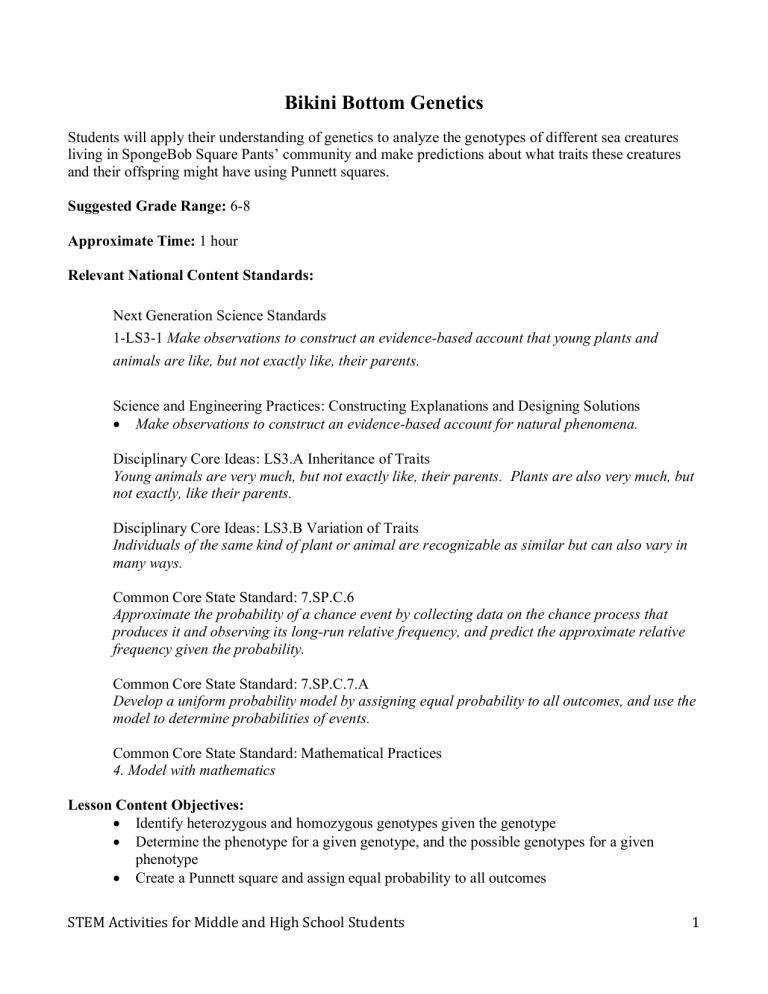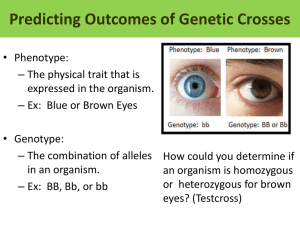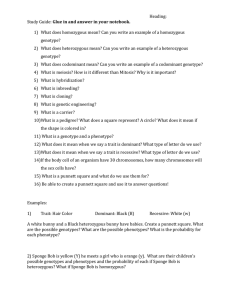
Bikini Bottom Genetics Students will apply their understanding of genetics to analyze the genotypes of different sea creatures living in SpongeBob Square Pants’ community and make predictions about what traits these creatures and their offspring might have using Punnett squares. Suggested Grade Range: 6-8 Approximate Time: 1 hour Relevant National Content Standards: Next Generation Science Standards 1-LS3-1 Make observations to construct an evidence-based account that young plants and animals are like, but not exactly like, their parents. Science and Engineering Practices: Constructing Explanations and Designing Solutions • Make observations to construct an evidence-based account for natural phenomena. Disciplinary Core Ideas: LS3.A Inheritance of Traits Young animals are very much, but not exactly like, their parents. Plants are also very much, but not exactly, like their parents. Disciplinary Core Ideas: LS3.B Variation of Traits Individuals of the same kind of plant or animal are recognizable as similar but can also vary in many ways. Common Core State Standard: 7.SP.C.6 Approximate the probability of a chance event by collecting data on the chance process that produces it and observing its long-run relative frequency, and predict the approximate relative frequency given the probability. Common Core State Standard: 7.SP.C.7.A Develop a uniform probability model by assigning equal probability to all outcomes, and use the model to determine probabilities of events. Common Core State Standard: Mathematical Practices 4. Model with mathematics Lesson Content Objectives: • Identify heterozygous and homozygous genotypes given the genotype • Determine the phenotype for a given genotype, and the possible genotypes for a given phenotype • Create a Punnett square and assign equal probability to all outcomes STEM Activities for Middle and High School Students 1 • Make predictions using a Punnett square and by calculating probabilities Materials Needed: • Activity sheets for each student (included) STEM Activities for Middle and High School Students 2 Summary of Lesson Sequence • Introduce the lesson by leading a discussion in which students share which of their traits they have inherited from their parents. • Discuss how different alleles of a gene may exist and how one organism can have a homozygous or heterozygous gene. Demonstrate how to distinguish between homozygous and heterozygous genes given genotypes. • Demonstrate identifying a phenotype from a given genotype as well as the possible genotypes from a given phenotype. • Demonstrate a Punnett square for organizing the possible genotypes for an offspring and calculating the probability that the offspring will have a given trait. • Allow students to apply their understanding to answer questions in small groups about the genetics of the sea creatures living in Bikini Bottom. • To close the lesson, have students share their findings in a whole class discussion. Assumed Prior Knowledge Prior to this lesson students should already be familiar with the following concepts and vocabulary: recessive allele, dominant allele, homozygous, heterozygous, genotype, phenotype, and Punnett square. This lesson allows students to apply their understanding of genetics. Students should also be able to develop a probability model by assigning equal probability to all the outcomes and use the model to determine the probability of an event. Classroom Set Up Allow students to work in small groups of three or four to complete the activity. Lesson Description Introduction Explain that many of us can identify physical traits that we have inherited from our parents. Have students discuss traits they can identify in themselves and their parents for example, attached or detached earlobes, tongue rolling, curly hair, freckles, dimples, handed-ness, and allergies. Input and Model Remind students that different alleles of a gene may exist and that one organism can have a homozygous or heterozygous gene. Example: Let us pretend there is a species of bird that will either have black eyes or yellow eyes, and having black eyes is the dominant trait. Since “black eyes” and “yellow eyes” are alleles (or two forms of the same gene), we will abbreviate them with the same letter: “B” for black eyes and “b” for yellow eyes. STEM Activities for Middle and High School Students 3 Then we can write out the possible genotypes and resulting phenotypes for the eye color of the birds: Symbol BB Bb bb Genotype Homozygou, Ho Heterozygous, He Homozygous, Ho Phenotype Black eyes Black eyes Yellow eyes If we observe one of these birds and we see it has black eyes, what are the possible genotypes it could have for this trait? (BB or Bb) What are the possible genotypes for a bird with yellow eyes? (only bb) If a Homozygous black-eyed bird (BB) mated with a yellow-eyed bird (bb), we can find the probabilities of the resulting offspring’s genotypes and phenotypes using a Punnett square. B b B BB Bb B BB Bb From the Punnett square, calculate the probabilities for the offspring: Homozygous black-eyed (50%) Heterozygous black-eyed (50%) Black-eyed (100%) Yellow-eyed (0%) Guide Students Through Their Practice Allow students to work in small groups to complete the “Bikini Bottom Genetics” activity. Check for Understanding While students are working together, ask the following guiding questions: How are traits passed down from parents to their children? How can genotype determine phenotype? Why do some children have traits that cannot be found in either parent? Do you or your siblings have any traits that neither of your parents have? How is the Punnett square useful for predicting the traits of offspring? Are each of the genotype outcomes in the Punnett square equally likely? What about the phenotype outcomes? What information do you need in order to complete the Punnett square? Closure Engage students in a whole group discussion to summarize answers to the guiding questions. STEM Activities for Middle and High School Students 4 Suggestions for Differentiation and Extension • Students can explore heredity and genetic variation at the Learn Genetics website which includes animated tours. (http://learn.genetics.utah.edu) • Students can also apply their understanding of how traits are passed from parents to offspring in an activity where they compare their personal traits with their classmates and create model chromosomes to share with a classmate (activity included). STEM Activities for Middle and High School Students 5 ` Name ______________________________ Bikini Bottom Genetics Investigate the genetic makeup of some of the sea creatures in SpongeBob Squarepants’ community and make predictions about their possible offspring! 1. Identify each genotype as Heterozygous (He) or Homozygous (Ho) Bb ____ DD ____ TT ____ Ff ____ dd ____ Dd ____ bb ____ 2. SpongeBob Squarepants has a Yellow body color, which is a dominant to blue body color for his species. For each genotype given for body color in sponges, determine the phenotype. YY _______________ Yy _______________ yy _______________ 3. SpongeBob is also Square, which is dominant to round. For the given genotype for body shape, determine the phenotype. SS _______________ Ss ________________ ss ________________ 4. Patrick has a Tall head (T), which is dominant to a short head (t), and he has a pink body (g), which is recessive to a Green body (G). Write the genotypes that are possible for Patrick’s phenotypes (there may be more than one possible answer): Head height _______________ Body color ________________ STEM Activities for Middle and High School Students 6 5. SpongeBob SquarePants is heterozygous for his square shape and his partner, SpongeBarbara, is round. Create a Punnett square to show the possibilities that would result if they had children. a. What are the chances of a child with a square shape? _______% b. What are the chances of a child with a round shape? _______% 6. Patrick and his partner Patricia recently had Lil’ Patty and Patricia is worried that the hospital made a mistake and mixed her baby with some other starfishes’. Lil’ Patty has a short head! Patrick is homozygous for his tall head and Patricia is heterozygous for her tall head. Create a Punnett square using T for the dominant gene and t for the recessive one. Did the hospital make a mistake? Explain your answer. STEM Activities for Middle and High School Students 7





